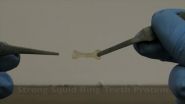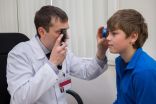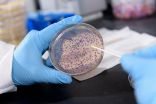INFORMATION:
Also working on this project at Penn State were Abdon Pena-Francesch and Huihun Jung, graduate students in engineering science and mechanics; and Carlos Pacheco, NMR spectroscopist.
Others include Metin Sitti, Max Planck Institute at Stuttgart, Germany and Carnegie Mellon University; Veikko Sariola, former postdoctoral fellow at Carnegie Mellon University; and Murat Cetinkaya, BASF SE, Ludwigshafen, Germany. Sariola and Pena-Francesch were co-first authors of this paper.
The Jenny and Antti Wihuri Foundation, Walter Ahlström Foundation, Academy of Finland, the National Science Foundation and the Office of Naval Research supported this work. END
Water heals a bioplastic
2015-09-01
(Press-News.org) A drop of water self-heals a multiphase polymer derived from the genetic code of squid ring teeth, which may someday extend the life of medical implants, fiber-optic cables and other hard to repair in place objects, according to an international team of researchers.
"What's unique about this plastic is the ability to stick itself back together with a drop of water," said Melik Demirel, professor of engineering science and mechanics, Penn State. "There are other materials that are self healing, but not with water."
Demirel and his team looked at the ring teeth of squid collected around the world -- in the Mediterranean, Atlantic, near Hawaii, Argentina and the Sea of Japan -- and found that proteins with self-healing properties are ubiquitous. However, as they note in a recent issue of Scientific Reports, "the yield of this proteinaceous material from natural sources is low (about 1 gram of squid ring teeth protein from 5 kilograms of squid) and the composition of native material varies between squid species."
So as not to deplete squid populations, and to have a uniform material, the researchers used biotechnology to create the proteins in bacteria. The polymer can then either be molded using heat or cast by solvent evaporation.
The two-part material is a copolymer consisting of an amorphous segment that is soft and a more structured molecular architecture. The structured portion consists of strands of amino acids connected by hydrogen bonds to form a twisted and/or pleated sheet. This part also provides strength for the polymer, but the amorphous segment provides the self-healing.
The researchers created a dog-bone shaped sample of the polymer and then cut it in half. Using warm water at about 113 degrees Fahrenheit -- slightly warmer than body temperature -- and a slight amount of pressure with a metal tool, the two halves reunited to reform the dog-bone shape. Strength tests showed that the material after healing was as strong as when originally created.
"If one of the fiber-optic cables under the ocean breaks, the only way to fix it is to replace it," said Demirel. "With this material, it would be possible to heal the cable and go on with operation, saving time and money.
"Maybe someday we could apply this approach to healing of wounds or other applications," he said. "It would be interesting in the long run to see if we could promote wound healing this way so that is where I'm going to focus now."
ELSE PRESS RELEASES FROM THIS DATE:
Suicide-by-firearm rates shift in 2 states after changes in state gun laws
2015-09-01
A new study examining changes in gun policy in two states finds that handgun purchaser licensing requirements influence suicide rates. Researchers estimate that Connecticut's 1995 law requiring individuals to obtain a permit or license to purchase a handgun after passing a background check was associated with a 15.4 percent reduction in firearm suicide rates, while Missouri's repeal of its handgun purchaser licensing law in 2007 was associated with a 16.1 percent increase in firearm suicide rates.
The study, from researchers with the Johns Hopkins Center for Gun Policy ...
Saving oysters by digging up their past
2015-09-01
ITHACA, N.Y. - Restoring oyster reefs is not an easy task, but by digging deep and examining centuries-old reefs, marine restoration professionals may stand a better chance at bringing oysters back, said a new Cornell University and Paleontological Research Institution (PRI) study published in the August issue of the Journal of Shellfish Research.
Stephen R. Durham, a Cornell doctoral student in the field of earth and atmospheric sciences, with Gregory P. Dietl, curator of Cenozoic invertebrates at the Cornell-affiliated PRI and a Cornell adjunct assistant professor of ...
Simplified handwashing steps help reduce sickness-related absenteeism for kids: Study
2015-09-01
Washington, DC, September 1, 2015 - A simplified handwashing routine, with five steps instead of seven, helps to reduce sickness-related absenteeism for students with mild intellectual disability (MID), according to a study published in the September issue of the American Journal of Infection Control, the official publication of the Association for Professionals in Infection Control and Epidemiology (APIC).
The study was conducted in two special education schools in Hong Kong. Researchers from The Hong Kong Polytechnic University developed a 12-week handwashing intervention ...
Hysterectomy can be safely combined with cosmetic surgery for 'hanging abdomen'
2015-09-01
September 1, 2015 - For women undergoing hysterectomy, removal of "hanging" abdominal fat and skin--a cosmetic procedure called panniculectomy--can be performed at the same surgery without increasing the risk of complications, reports a study in the September issue of Plastic and Reconstructive Surgery®, the official medical journal of the American Society of Plastic Surgeons (ASPS).
"This is among the best evidence to date regarding 30-day risk profiles, and the data suggests that the complication rates are comparable for patients undergoing combined hysterectomy ...
Gene may predict severity of post-traumatic stress disorder
2015-09-01
(Boston)--A gene linked in previous research, appears to predict more severe post-traumatic stress disorder (PTSD) symptoms as well as a thinner cortex in regions of the brain critical for regulating strong emotions and coping with stressful experiences. This study is believed to be the first to show that the spindle and kinetochore-associated complex subunit 2 (SKA2) gene may play a role in the development of PTSD.
Led by researchers at Boston University School of Medicine (BUSM), the National Center for PTSD and the Translational Research Center for TBI and Stress ...
First global antineutrino emission map highlights Earth's energy budget
2015-09-01
The neutrino and its antimatter cousin, the antineutrino, are the tiniest subatomic particles known to science. These particles are byproducts of nuclear reactions within stars (including our sun), supernovae, black holes and human-made nuclear reactors. They also result from radioactive decay processes deep within the Earth, where radioactive heat and the heat left over from the planet's formation fuels plate tectonics, volcanoes and Earth's magnetic field.
Now, a team of geologists and physicists has generated the world's first global map of antineutrino emissions. ...
Diabetic retinopathy screening for children with type 1 diabetes should start later
2015-09-01
A new study has found that the occurrence of advanced forms of a diabetic eye disease remains low among children living with diabetes, regardless of how long they have had the disease or their ability to keep blood sugar levels controlled. Researchers are therefore recommending that most children with type 1 diabetes delay annual diabetic retinopathy screenings until age 15, or 5 years after their diabetes diagnosis, whichever occurs later. Their findings were published online today in Ophthalmology, the journal of the American Academy of Ophthalmology.
It is well established ...
'Bacterial litmus test' provides inexpensive measurement of micronutrients
2015-09-01
A bacterium engineered to produce different pigments in response to varying levels of a micronutrient in blood samples could give health officials an inexpensive way to detect nutritional deficiencies in resource-limited areas of the world. This "bacterial litmus test," which currently measures levels of zinc, would require no electrical equipment and make results visible as simple color changes.
More than a billion people worldwide may be at risk for adequate zinc intake, but measuring zinc levels in blood samples currently requires sophisticated testing equipment not ...
Reading emotions in a second language
2015-09-01
In the "NeverEnding Story", Bastian feels so involved in the narration that he experiences the same emotions as the characters (and in the end he really enters the book). What happens to the main character of Micheal Ende's book is exactly what happens to each of us when we read a novel or a short story: we literally replicate the physiological processes and emotions of the characters described in the text. Francesco Foroni, research scientist at the International School for Advanced Studies (SISSA) of Trieste, already demonstrated this phenomenon a few years ago in a study ...
The timing of sleep just as important as quantity
2015-09-01
PULLMAN, Wash.--Washington State University researchers have found that the timing of an animal's sleep can be just as important as how much sleeps it gets.
Ilia Karatsoreos, an assistant professor in WSU's Department of Integrative Physiology and Neuroscience, shifted mice from their usual cycle of sleeping and waking and saw that, while they got enough sleep, it was of poorer quality. The animals also had a disrupted immune response, leaving them more open to illness.
Most sleep research focuses on the effects of sleep deprivation or the overall amount of sleep an animal ...


